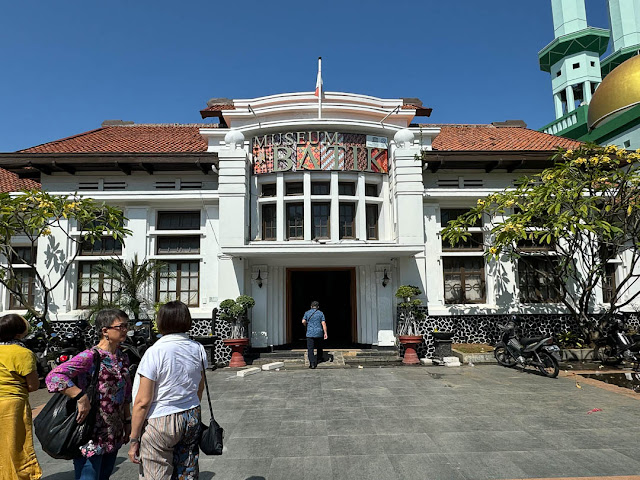The Pekalongan Batik Museum, a modest yet treasure trove, awaited us next. Permanent displays offered a glimpse into the history of batik, while a rotating exhibit explored the fascinating world of "Batik Awisan/Larangan." These were court batiks, exclusive to the rulers and elite of the Mataram palace (encompassing Yogyakarta and Surakarta). The motifs themselves held profound meaning, reflecting the wearer's social status and aspirations. Larangan Batik, with its intricate patterns like "parang rusak" and "cemukiran," possessed a near-sacred quality. The belief that these motifs could not only evoke spiritual moods but also spread a mystical aura added another layer of intrigue.
Understanding these prohibited motifs, the museum argued, allowed us to appreciate batik not just as fabric, but as a vessel of philosophy and ancestral wisdom.
The temporary exhibit, as well as the courtly world, also showcased the batik of the common people. Here, batik was woven into the fabric of daily life, its patterns reflecting rituals and ceremonies. Each symbol whispered a moral message, a silent prayer for good fortune. The batik used in these ceremonies, displayed with reverence, spoke volumes about the Javanese reverence for balance and harmony.
The permanent collection unveiled a treasure trove of tools – "Tok Wi" workbenches, textile samples, and demonstrations of various techniques. Tok Wi, I learned, was once reserved for Chinese royalty but eventually found its way into Javanese culture, symbolizing strength, longevity, and prosperity through its auspicious motifs.
Then came the highlight – my own foray into batik creation. Inspired by a photo I found of Madam Gouw's, I attempted a "Batik Tulisan," hand-drawing a design featuring a curious doll head with a European face and a curly moustache. It was a messy but thoroughly enjoyable experience, one that I suspect resonated with the rest of the group.
Our next stop was Atelier Ibu Utin, a hidden gem with no Google Map footprint. Here, the rhythmic chanting of women working filled the air. Friday, a traditional day of rest, had us wondering if this was a special performance just for us.
The answer lay in Riefayah Batik, a unique tradition from Batang. Founded by Kiai Rifa'i, it intertwined batik creation with Islamic teachings. Prayers and hymns accompanied the intricate, floral motifs, adhering to Islamic restrictions on depicting living creatures. Riefayah Batik, a testament to the legacy of Kiai Rifa'i and the generations of women who followed, stood as a vibrant symbol of cultural and religious heritage.
Ibu Utin's atelier echoed this philosophy. In my YouTube interview with her, I discovered her emphasis on "Sabar" – patience. She spoke of the skills and knowledge passed down, the cultural preservation, the spiritual development, and the confidence fostered through this art form. The sheer number of intricate dots and patterns on a single piece was a testament to their dedication. Ibu Utin lamented the dwindling number of female batik makers, from 120 to a mere 32.
It was here, amidst the rhythmic chanting and the air thick with tradition, that I finally succumbed to the allure of batik. A photo by Catherine captured the moment – me and Ibu Utin, my conquest, a piece of Riefayah Batik, held proudly. As someone aptly captioned it, I was no longer a "Batik virgin,” it was my first purchase of a handmade Batik. The Pekalongan Batik Museum opened my eyes to the symbolism, the spirituality, and the sheer artistry that lay woven into the fabric of this ancient Javanese tradition.
#wheeteck #wheetecktravel #wheetecktravelogue


















No comments:
Post a Comment